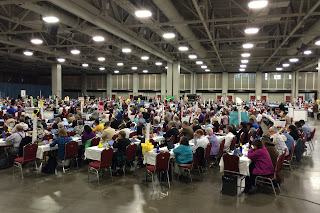St. John’s College, Santa Fe, New Mexico, August 1, 2016
I offer the following reflections as one footnote to Barry
Moser’s moving and insightful presentation at the 2016 Glen Workshop. These are
some things we might think about. The reflections are stated briefly and without much elaboration, and they are tentative, so I welcome your feedback and
discussion.
The main thesis is that, in
some circumstances, racism is natural and to be expected, but people of faith
are obliged both to work to remedy those circumstances and to cultivate in
ourselves, our children, and our communities a second nature in which our responses
are redeemed and transformed toward love.
1.
All humans, when we feel threatened, distinguish friend from
foe, us from them. When not threatened, we may not draw such a distinction. That we make this distinction when
feeling threatened is hardwired. Collies herd. Retrievers fetch. Humans
distinguish friend from foe. How we
make the distinction is learned during childhood and/or is circumstantial,
influenced by features of the particular situation.
2.
Hundreds of thousands of years of human evolution have
rewarded (“selected for”) tendencies for in-group preference and in-group
loyalty.
The typical
human group for hundreds of thousands of years was what is sometimes called a
“hunter-gatherer group” or “small band foraging society,” composed normally of
5 to 7 families of 5 to 7 individuals each, or about 25-50 people.
During the late Pleistocene era,
before the current Holocene era, radical climate shifts and associated
fluctuations in food scarcity led to the flourishing and then diminishing of human
populations. Our human ancestors who survived the bad times were the ones who
stuck together and looked out for each other in their small groups. Others
mostly died off.
Jon Haidt (The Righteous Mind, 2012) proposes this thought experiment: If,
tomorrow, 90% of the world’s food supply vanished, who would make it? It would
be individuals in cohesive, cooperating groups, not strong individuals who
bully or try to survive by force.
3.
“Race” is a common way people distinguish friend from foe.
Race categories, like those on the U.S. Census, and the way individuals make
their own classifications by race, are best understood as involving reference
to a combination of phenotype (outward appearance) and ethnicity (cultural
ways).
When someone says, “race is not
biological,” they mean that there are no genetic markers for race. Of course
phenotype is based on genotype. For instance, skin color, hair texture, nose
shape, and eye shape are results of complex genetic codes within human DNA, and
these are inherited. But socially determined race categories do not coincide
with any interconnected markers for these physical traits. You can’t examine
DNA to determine race. Race is not genetic.
Here’s the idea: If we categorized
humans into racial groups, then took objective measurements on those four
physical traits of every individual in each group, and then calculated average
measurements for each racial group, the differences between individuals within
the race groups on the four traits would be larger than the differences between
the average measurements for each group. For instance, there is more variation
of skin color within socially agreed upon racial groups than there is between
the average skin colors of the different groups.
Though race is not biological, it
is cultural. This means two things. First, it means that in different cultures,
people use different race categories for understanding human differences, based
on the histories of their own cultures. For instance, the race category scheme
symbolized by the phrase “red, yellow, black, and white” is not universal. It
wouldn’t have made sense in Jesus’ day of what they took to be the crucial
difference between Jews and Samaritans, or what in the Middle East today are
the differences between Jews, Arabs, and Persians.
Second, the statement that race is
cultural means that in making race distinctions people have in mind not only
outward appearance but also differences in social customs and family ways,
though the generalizations we make about the customs and ways of different
races almost always have exceptions.
4.
In the Christian idiom and metaphor scheme, our nature as “fallen”
puts us in need of redemption and the continual working of God in our lives.
Racism, according to this
understanding, is sinful but is not caused by exceptional ignorance or
depravity. It is a product of the human evolution of motivational impulses in
conditions when we feel threatened. That
is, racism is a natural condition that God calls us to transform.
Cross-racial friendships and associations
help cultivate a sense of “us” across socially specified race groups.
Emphasizing differences and diversity is not as successful for cultivating “us”
as is emphasizing shared purposes independently of race. This is part of loving
our neighbors as ourselves.
But Jesus also teaches us to remedy
the conditions in which people are and feel threatened. As followers of Christ,
we do wrong when we either foster threatening conditions or passively benefit
from them, for instance, when we either promote racial segregation or take
advantage of race-based privilege in making the best life for our children that
we can (when our privilege means others are denied privilege). For many whites, not being racist is easy. Facing up to white privilege is hard.
5.
The beloved community is not simply color-blind. Not being
an active racist is not enough. We have to cultivate a second nature, one
redeemed and transformed, which some people would call “anti-racism.” How can
one be an anti-racist? The beloved community is one in which we both remedy the conditions in which
people feel threatened and cultivate
love and shared purpose across social and ethnic divisions. Only then do we love our neighbors as our
selves.






















